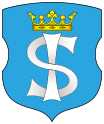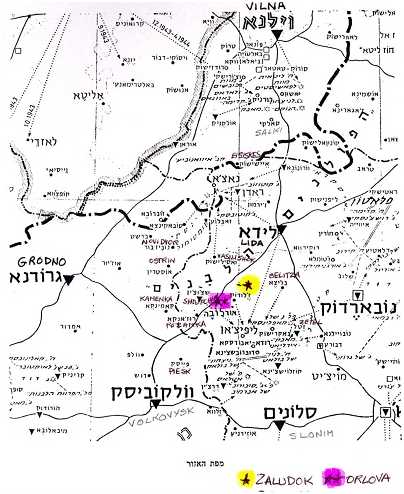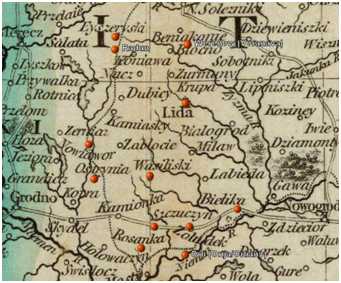 SCUCYN
SCUCYN 
and
the dependent villages of Albinowce, Andruyushetvtsy/Andruszowce
at 53º40' 24º38' , Bale I and II, Bartosze, Bojary
Male, Bojary Wielkie, Bujwicze, Domuciowce, Dubrowlany, Gierniki Nowe,
Gierniki Stare, Gudi, Ishelin/Ishchelnyany/Ishcholyany/Ishcolnyany/Iszczona/Ischalna/
Iszczolna/Stary Yederniki at 53º40' 24º55',
Jabloszowce, Janczuki, Juciowce, Jurowszczyzna, Kaleczyce, Kiemiany,
Koropki, Kozarcze, Krasna, Kulaki, Kuwerki, Lack, Maciowce, Micary,
Mikolajkowszczyzna, Murawjowka, Naumowce, Nowosady Iszczolskie,
Nowosiolki, Ogrodniki, Paszkowszczyzna, Pilczuki, Planty, Rohacze,
Rzeszotniki, Sajdaki, Skragi, Solohubowce, Spusza, Starodworce,
Topiliszki, Turowka, Worony, Zagunie, Zajkowszczyzna, Zarzecze, Zylicze
and
the estates, colonies, and hamlets of Andruyushetvtsy/Andruszowce
at 53º40'
24º38',
Baranowszczyzna, Bojary, Buciowszczyzna, Czaplicowszczyzna,
Czarnowszczyzna, Dojlidowszczyzna, Domuciowce, Dorgiowce,
Dzaplidzowszczyzna, Giernickzka, Gierniki, Iszczolna, Janowszczyzna,
Jatwiesk, Klemiany, Kozarcze, Korzyse (Pieski), Lack Koscielny,
Leszczanka, Krzywosiolki, Kudra, Kuwerki, Leszczanka, Marysin,
Masliszki, Meldziny, Mikolajkowszczyzna, Nowosady, Nowosady
Krasnowskie, Pietrulewszczyzna, Planty, Poplawy, Prejca, Rodziewicze,
Romaniszki, Siemienie, Siewkowszczyzna, Sliwowszczyzna, Slonna,
Smolarnia, Stara Jelna, Starodworce, Swojatycze, Szczuczynek,
Szczuczyn, Szczyczynek, Szuly, Talkowszczyzna, Talmontowszczyzna,
Topiliszki, Turja, Trynapol, Turja, Waclawowo, Wady, Wity, Wnuczkowce
2010
population was nearly 15,000. [Not Szczuczyn, Poland (Łomża gubernia,
near Białystok although both towns were called "Szczuczyn, Poland"
between the WWI and WWII]. Jewish population: 1,356 (in 1897), ~2,000
(in 1930).
The first known official mention of Scucyn is 1436, but the settlement
dates from 1537 when Scucyn was mentioned in the Book of Acts
of the Lithuanian Metrica (Lithuanian vital records), held in
the Government Archive in Lithuania. Ownership of Scucyn passed from
noble Radziwiłł family, then the Drutskiya-Liubetskis, the Scipions,
and others. In the 15th–18th centuries, Scucyn became a
member of the Lida council of the Vilnius voivode. In the first half of
the 17th century, Scucyn was governed by the marshal of the Lithuanian
principality, Scipio de Campo. Scucyn was an average-sized privately
owned village in terms of population.
A
1726 Sejm resolution established the Catholic Monasterial Order. The
Board of Scucyn was one of the biggest in Belarus. Scucyn was subject
to ruin and ravage more than once in its history, the biggest during
the North War when the town was seized by Swedish king Karl XII. After
the third partition of the Polish–Lithuanian Commonwealth in
1795, Scucyn became part of the Russian Empire. In June 1812, Scucyn
was occupied by French troops and in 1915 by the German Kaiser. In
1919, the Red Army attempted to seize Belorussian land by taking the
railroad line. However, superior defense forced the Red Army back.
In 1939,
Western Belarus including
Scucyn went under Soviet control. In World War II, Scucyn was occupied
by German troops when from June 25, 1941 until July 13, 1944 the Nazi
forces killed about 2180 Jews from Scucyn ghetto, the majority on May
9-10, 1942. Until the collapse of the Soviet Union, Scucyn was a home
of one of the biggest Soviet air bases going back into 1941.
Andruszowce: village in
Lida powiat, Catholic parish Lack, post office Szczyczyn, Lithuania, 5
mila from Lida; farms 34; 45 domiciles, inhabitants: 340, open area: 74
wlok, of which
14 belong to the peasants according to the decree of 1864; forest 20 wlok, meadow
and pasture 15 wlok, wateland
10 wlok; remainder
cultivated land with good soil. Cylindrical water mill., the profits of
which belonged to the Narbut families for many years, i and in 1849 the
inheritance right passed to the Moraczewski family and and today is the
state property of the heirs of Adam Moraczewski. There are many kurhan
[mounds erected as tombs], rich material for archeology.
Ischalna,
today, is a village in Schutchin district located twelve kilometers
from Schutchin and eight kilometers from the railway station
Skribovtsy. The 1995 population was 90 people with 38 houses.
Ischalna
was first mentioned in the Chronicles at the end of fifteenth century
to the beginning of the sixteenth century as an estate in Lida povet
belonging to Davoinovich. In 1515, he established the St. Trinity
Catholic church there. In 1547, Stanislav Davoinovich established a
mestechko at Ischalna. In the seventeenth century it belonged to Limont
Vishnevetski, Palupyaty, Radimin-Frantzkevich, and Skarbek Vazhinski.
In 1690, fifty-three houses existed.
In
1758, U. Val built a brick Catholic church. Beginning in 1795 the
Russian Empire governed the area. In the nineteenth century, Ischalna
was mestzechko and a village in Schutchin Oblast in Lida povet, Vilna
guberniya and belonged to Skarbek Vazhinski. In 1897, there were 118
people, fourteen houses and a post office. In 1915, the German Army
occupied it. The Red Army and Polish Army occupied it from1919 to 1920.
In 1921-1939 Ischalna belonged to Poland as a village in Schutchin
gmina, Lida povet, Novogrudok Voevodstvo. Beginning 1939 the BSSR
assumed control. During World War II, the Nazis captured Ischalna.
Beginning April 17, 1962, Ischalna belonged to Scucyn district with a
collective farm "Bolshoe Mozheikovo", a post office and a shop.
Architectural monument: St. Trinity Catholic Church (1758)
(Sachenka, vol. 3, p.511)
[Translations
by Ellen Renck and Jan Sekta].
Translation
of the Slownik
Geograficzny entry for Iszczolna
Translation
of the Slownik
Geographiczny entry for Scucyn
Resources:
- The
Holocaust in Scucyn
- Holocaust in Scucyn
on Yahad in Unum site.
- Jewish
Cemetery (or go directly to the
photographs: Roll 1 Roll 2
Roll 3
Roll 4
- Sefer
zikaron le-kehilot Szczuczyn, Wasiliszki, Ostryna, Nowy-Dwor, Rozanka (Tel Aviv,
1966) (Yizkor)
- LitvakSIG
- JewishGen
Belarus SIG
- Słownik
Geograficzny Królestwa Polskiego (1880-1902),
XI, pp. 864-865: "Szczuczyn" #1.
https://www.polishroots.org/slownik/szczuczyn.htm
- Barbara Proko's translation of
the Slownik
entry.
- Shtetl
Finder (1980),
p.
89: "Sh'chuchin, Stutchin".
- Pinkas
HaKehilot,
Poland,
Vol. 8 (2005), pp. 621-625: "Szczuczyn".
- Encyclopedia
of Jewish Life (2001), p.
1276: "Szczuczyn (II)".
- Еврейская
энциклопедия (1906-1913),
"Щучин, местечко". Minimal entry. The link we had is no longer
functional (2021). See the Wikipedia
page for this work . "References" lists two links to this
work - in Russian.
- Russian-language
wikipedia page (see the bottom for some pictures)
- Photos
of Scucyn in Belarus Guide
- Wikipedia.
- town
images: go to the internet archive
Wayback Machine & paste in
https://schuchin.narod.ru/gallery.html . Choose 2016 & click on
one of the calendar dates with a blue star
If
you have Lida uezd
materials to share, please considering donating it.
If you read Yiddish or Hebrew, please contact us.
Records are
held both in Grodno and Vilna archives.For Lida records translation,
your tax deductible contribution by credit card via the secure server
at either group or by mail will grow our knowledge. For a $100
donation, you receive all these records translated two years ahead of
their posting on JewishGen. Every penny collected is used for Lida uezd
projects only. Records include censuses; family lists; marriages,
births, death records; prenumeraten lists; and more. Please contact Judy Baston
with any questions.For current translations, please see the ALD:
All Lithuanian Database and Belarus
SIG Database.
|

 SCUCYN
SCUCYN 
